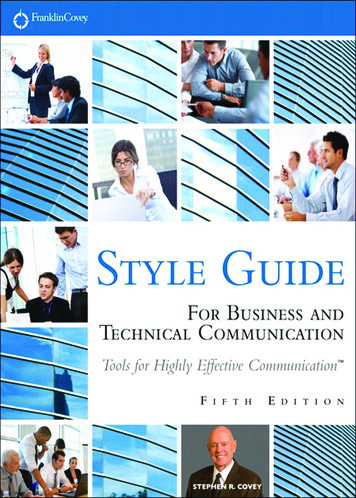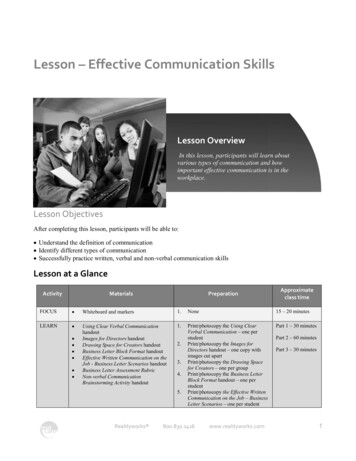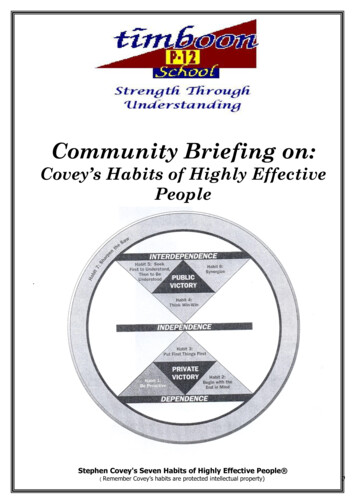
Transcription
Style GuideTMFOR BUSINESS AND TECHNICAL COMMUNICATIONTOOLS FOR HIGHLY EFFECTIVE COMMUNICATION FIFTH EDITION
PrefaceEffective communication is the essence of goodbusiness. We serve customers, co-workers,employers, suppliers, and the community wellby sharing relevant information clearly and efficiently.We fail to serve them when we communicate in unclear,bland, misleading, or irrelevant ways. That’s why thisbook is essential to all organizations—businesses,government agencies, or educational institutions.The aim of this fifth edition of the FranklinCovey StyleGuide for Business and Technical Communication is tohelp you serve your customers and co-workers in theseways: You will be complying with the best current practicesin business and technical communication. You will solve problems more effectively and makebetter decisions.Comply with the best current practices in businessand technical communication. Many useful stylebooksserve the needs of professional writers, scholars, editors,and publishers. This book, by contrast, is for people inthe business and technical professions. All guidelines,examples, and model documents come from the real“world of work” rather than from the academic world.Everything in this book has been tested and refined inworkshops with thousands of professionals literallyaround the world—from the oilfields of Saudi Arabiaand Indonesia to the pharmaceutical industry ofSwitzerland to the aerospace, engineering, service, andmanufacturing centers of North America and Europe.Solve problems more effectively and make betterdecisions. Writing in the workplace is far more thanpumping out emails, checking grammar, and fixingspelling. It is a problem-solving and decision-makingprocess. Cogent and persuasive business plans allowswift, logical management decisions. Analytic andiiwell-crafted scientific reports lead to robust dialogueand sound policy decisions. Well-designed and clearlywritten user information builds customer loyalty andprevents costly downtimes.New in the Fifth EditionThe most current guidelines on email, informationmanagement, and online documentation. Learnhow to manage the flood of email coming at youand to get results from the email you send. Find outhow to add distinctiveness and power to your onlinepresence.Updated best practices for graphics. Here’s the bestcurrent thinking on visuals for documents andpresentations, charts, color, illustrations, maps, photos,and tables—including all new examples.Guidance on global English. There is a new section onEnglish as a second language for business professionals,as well as updated guidance on international businessEnglish.Valuable new insights for knowledge workers. Learnnew ways to think and process information better inupdated sections on thinking strategies and the writingprocess, as well as practical guidance for managingprojects and meetings.Model documents for today. As email supplantstraditional business letters and memos, you need newmodels to follow. See the Model Documents section forupdated samples of sensitive emails, reports, proposals,procedures, and resumes.Everything in this fifth edition has been updated to helpyou meet the communication challenges of the hightech, high-demand business world of today. FranklinCovey
Improving Communication QualityBusiness Communication Solutions from FranklinCoveyThe ChallengeTraining Programs for Effective CommunicationBusiness professionals devote hours every day tocommunication tasks in the workplace. Much of thiscommunication is hampered by unproductive thinking,weak attempts at persuasion, poor organization, anda lack of basic writing skill that undercuts credibility.Floods of useless emails swamp and slow the wholeorganization. Web content lacks distinctiveness andpower. Poorly managed, inconclusive meetings eat uptime. Weak sales presentations fail to sway customers. Writing Advantage : Business Writing Skills forProfessionals Presentation Advantage : Professional PresentingSkills Meeting Advantage : How to Lead Great Meetings Technical Writing Advantage : Writing Skills forTechnical Professionals Leading at the Speed of Trust One dramatic way to increase your productivity is toimprove your communication processes and skills. Working at the Speed of Trust The SolutionFor more information on FranklinCovey training andconsulting, visit our website at franklincovey.com/tc.FranklinCovey offers tools, training, and services to helppeople and organizations do the great things they arecapable of. Our mission is to enable great performance.We train more than a quarter of a million people everyyear worldwide in leadership, trust building, execution,and communication. Our unique approach is to challengethe paradigms that hold people back and unshackle themby teaching them new, more effective paradigms.FranklinCovey training and consulting is available in liveand online formats.Instructor-Led Options. Experienced FranklinCoveyconsultants or certified facilitators teach our workshopsonsite. These workshops can be customized to addressthe specific needs, challenges, and objectives of yourorganization.Online Options. FranklinCovey’s LiveClicks webinarworkshops led by our consultants make our high-qualityinstruction available online. Engaging and interactive,these two-hour modules offer compelling skills trainingthrough award-winning videos, case studies, quizzes,and group discussion. FranklinCoveyiii
ContentsAlphabeticalPreface.iiImproving Communication Quality.iiiContents. ivForeward.viiiAuthor Acknowledgements. ixReference GlossaryUsing the Reference Glossary (Introduction). 2Abbreviations. 3Acronyms. 8Active/Passive. 9Adjectives. 12Adverbs. 15Agreement. 16Apostrophes. 19Appendices. 21Articles. 23Bias-Free Language. 25Bibliographies. 29Boldface. 32Brackets. 33British English. 34Capitals. 36Captions. 40Charts. 43Citations. 50Cliches. 51Colons. 54Color. 55Commas. 60Compound Words. 63Conjunctions. 65Contractions. 68Dashes. 69Decimals. 70Editing and Proofreading. 71Electronic Mail. 74Ellipses. 78Emphasis. 79English as a Second Language. 82Ethics. 86Exclamation Marks. 88False Subjects. 89Faxes. 90Footnotes. 92Fractions. 94Gobbledygook. 95Graphics for Documents. 97Graphics for Presentations. 103Graphs. 111Headings. 121.Hyphens. 124ivIllustrations. 126Indexes. 132Intellectual Property. 134International Business English. 137Introductions. 139Italics. 141Jargon. 143Key Words. 144Letters. 145Lists. 164Managing Information. 167Maps. 170Mathematical Notations. 177Meetings Management. 179Memos. 182Metrics. 185Modifiers. 191Nouns. 193Numbering Systems. 194Numbers. 195Online Documentation. 197Organization. 202Outlines. 208Page Layout. 210Paragraphs. 217Parallelism. 222Parentheses. 223Periods. 225Persuasion. 226Photographs. 230Plurals. 238Possessives. 240Prepositions. 242Presentations. 243Project Management. 246Pronouns. 251Punctuation. 256Question Marks. 258Quotation Marks. 259Quotations. 261Redundant Words. 262References. 264Repetition. 267Reports. 269Resumes. 274Scientific/Technical Style. 278Semicolons. 281Sentences. 282 FranklinCovey
ContentsAlphabeticalSigns and Symbols. 286Slashes. 288Spacing. 289Spelling. 291Strong Verbs. 296Style. 297Summaries. 301Tables. 303Tables of Contents. 311Thinking Strategies. 314Titles. 317Tone. 319Transitions. 322Underlining. 323Units of Measurement. 324Verbs. 325Word Problems. 328Word Processing. 340Wordy Phrases. 345Writing and Revising. 347Model DocumentsUsing Model Documents (Introduction). 358LettersResponse: With Information and Directions. 359Response: To a Concerned Customer. 360Response: To a Complaint. 362Complaint: With a Request for Action. 363Complaint: With a Tactful Request for Aid. 364Employment Reference. 366Employment Verification. 368Bid Solicitation. 369Sales: With a Soft Sell. 370Sales: Template/Mail Merge. 373Customer Service. 374MemosProcedure. 376Request: For Clarification of a Problem. 378Summary: For an Executive Audience. 380Proposal: To an Antagonistic Audience. 382Request: With Informal Instructions. 384Technical: With a Recommendation. 387Recommendation. 388Status Report: With an Outcome Orientation. 389Safety: With a Mild Reprimand. 390Personnel: With Suggested Procedures. 391Response: With Instructions. 392Transmittal: For Attachments. 394OthersResume: Problem-Solution Format. 395Resume: Performance Format. 396Resume Cover Letter. 397Minutes. 398Job Description. 400Executive Summary: For a Proposal(Financial Services). 401Executive Summary: For a Proposal (Training). 402Executive Summary: For an Audit. 404Marketing Fact Sheet. 405Mission Statement. 406Procedure: For a Business Process. 408Procedure: For a Technical Process. 411Technical Report. 415Web Page: With Informative Content. 419Index. 421 FranklinCoveyv
ContentsTopicalDocument DesignAppendices. 21Boldface. 32Emphasis. 79Headings. 121Introductions. 139Italics. 141Lists. 164Organization. 202Page Layout. 210Paragraphs. 217Spacing. 289Underlining. 323FormatsBibliographies. 29Citations. 50Electronic Mail. 74Faxes. 90Footnotes. 92Indexes. 132Letters. 145Memos. 182Online Documentation. 197Outlines. 208Quotations. 261Reports. 269Resumes. 274Summaries. 301Tables of Contents. 311Model DocumentsLetters. 359Memos. 376Others. 395NumbersDecimals. 70Fractions. 94Mathematical Notations. 177Metrics. 185Numbering Systems. 194Numbers. 195Units of Measurement. 324Parts of SpeechAdjectives. 12Adverbs. 15Articles. 23Conjunctions. 65Nouns. 193Prepositions. 242Pronouns. 251Verbs. 325GraphicsCaptions. 40Charts. 43Color. 55Graphics for Documents. 97Graphics for Presentations. 103Graphs. 111Illustrations. 126Maps. 170Photographs. 230Tables. 303vi FranklinCovey
ContentsTopicalPunctuationApostrophes. 19Brackets. 33Capitals. 36Colons. 54Commas. 60Dashes. 69Ellipses. 78Exclamation Marks. 88Hyphens. 124Parentheses. 223Periods. 225Punctuation. 256Question Marks. 258Quotation Marks. 259Semicolons. 281Slashes. 288Titles. 317Sentence StyleActive/Passive. 9False Subjects. 89Key Words. 144Parallelism. 222Repetition. 267Sentences. 282Strong Verbs. 296Style. 297Tone. 319Transitions. 322Word ChoiceAbbreviations. 3Acronyms. 8Agreement. 16Bias-Free Language. 25British English. 34Cliches. 51Compound Words. 63Contractions. 68English as a Second Language. 82Gobbledygook. 95International Business English. 137Jargon. 143Modifiers. 191Plurals. 238Possessives. 240Redundant Words. 262Scientific/Technical Style. 278Signs and Symbols. 286Spelling. 291Word Problems. 328Wordy Phrases. 345Skills/ProcessesEditing and Proofreading. 71Ethics. 86Intellectual Property. 134Managing Information. 167Meetings Management. 179Persuasion. 226Presentations. 243Project Management. 246References. 264Thinking Strategies. 314Word Processing. 340Writing and Revising. 347 FranklinCoveyvii
ForewordThis is a book for the Knowledge Age.In the 21st century, value is created by knowledgework—the analysis, research, design, and developmentwork done by strategists, scientists, technologists, andservice professionals. Knowledge work and writing areroughly the same process: a document or presentationis the means of creating value in a high-tech world.Clearly, the value of the chemicals in a bottle of lifesaving pills is negligible, but the value of the researchand knowledge documented in the package insert isincalculable. The value of the silicon in a computer chipis slight, but the value of the knowledge embodied inthe research reports, patent documents, and proceduresis substantial. The documents are your best thinkingmade visible and sharable.Although this book gives practical guidance on businessgrammar and usage, it does far more than that. You willfind here guidelines to help you think and communicatemore productively: to manage information efficiently,present persuasivel
The aim of this fifth edition of the FranklinCovey Style Guide for Business and Technical Communication is to help you serve your customers and co-workers in these ways: You will be complying with the best current practices in business and technical communication. You will s










